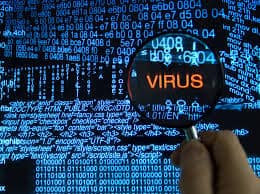
What is VIRUS (in computer systems)?
A Virus is any piece of code that is deliberately written to cause damage or annoyance to computer users on a network. Tens of thousands of different “strains” of viruses have been detected over the years. The effects of these viruses range from harmless messages announcing the presence of an “infection” to malicious deletion of crucial system and data files. The first recorded PC virus was the Pakistani Brain virus detected in 1987.
Computer Virus is one of the most common security threats in computer networks.
Common categories of viruses include the following:
- Boot-sector viruses: Viruses that infect the boot sector of a floppy or hard disk and execute when a system is booted, causing various kinds of damage, including totally disabling systems. Notorious boot viruses have included the Michelangelo virus and the Stoned virus.
- File viruses: Viruses that reproduce by attaching themselves to executable (.exe) files. When the executable file is run, the virus code is executed, causing the virus to reproduce itself and (typically) damage user files in the process.
- Polymorphic viruses: Viruses that evolve as they reproduce, causing their signature to change and making them difficult to detect unless the specific evolution algorithm is known.
- Macro viruses: Increasingly popular viruses written in the form of macros for word processing and spreadsheet applications. When the macro is executed, the virus infects the system and typically results in loss of files.
Other malicious programs
Related types of malicious programs that are not strictly viruses because they do not reproduce can have similar effects. These include the following:
- Trojan horses: Programs that masquerade as other programs and are typically used to steal credentials or other information from a user
- Worms: Programs that invade memory to destroy files but are not disk-resident
- Logic bombs: Programs that are triggered when a certain event or sequence of events occurs
Many malicious programs combine the properties of viruses with one or more of these programs and are not easy to categorize.
How to avoid virus and keep your system up and running
To keep viruses from proliferating on your network, you can take the following measures:
- Install top-quality virus-scanning software on each computer in your network, and keep their virus information files up to date.
- Be sure that your anti-virus software scans for viruses in Hypertext Markup Language (HTML) files and attachments to Simple Mail Transfer Protocol (SMTP) e-mail messages if you have Internet connectivity.
- Regularly perform backups of all important servers and include periodic archives in your backup schedule, since many viruses do not activate for weeks or months after infection.
- Scan new computers for infection before bringing them onto the network.
- Issue a company policy prohibiting users from installing any personal programs on their desktop computers. You might even disable their floppy drives, because infection via floppy is a common route to virus infection.
How Computer Virus started?
The first academic work on the theory of self-replicating computer programs was done in 1949 by John von Neumann who gave lectures at the University of Illinois about the “Theory and Organization of Complicated Automata“. The work of von Neumann was later published as the “Theory of self-reproducing automata”. In his essay von Neumann described how a computer program could be designed to reproduce itself. Von Neumann’s design for a self-reproducing computer program is considered the world’s first computer virus, and he is considered to be the theoretical “father” of computer virology.
Creeper Virus
The Creeper virus was first detected on ARPANET, the forerunner of the Internet, in the early 1970s. Creeper was an experimental self-replicating program written by Bob Thomas at BBN Technologies in 1971. Creeper used the ARPANET to infect DEC PDP-10 computers running the TENEX operating system. Creeper gained access via the ARPANET and copied itself to the remote system where the message, “I’m the creeper, catch me if you can!” was displayed. The Reaper program was created to delete Creeper.
Elk Cloner Virus
In 1982, a program called “Elk Cloner” was the first personal computer virus to appear “in the wild” – that is, outside the single computer or Computer Lab where it was created. Written in 1981 by Richard Skrenta, a ninth-grader at Mount Lebanon High School near Pittsburgh, it attached itself to the Apple DOS 3.3 operating system and spread via floppy disk. On its 50th use the Elk Cloner virus would be activated, infecting the personal computer and displaying a short poem beginning “Elk Cloner: The program with a personality.”